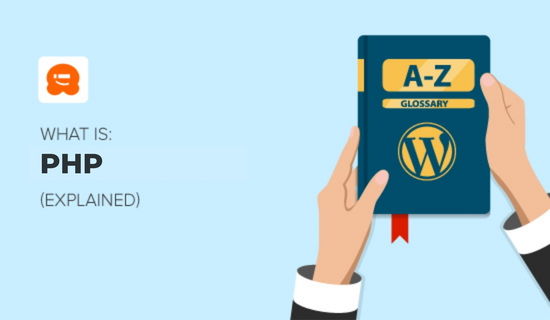What is: PHP
PHP is a programming and scripting language to create dynamic interactive websites. WordPress is written using PHP as the scripting language. Just like WordPress, PHP is also open source.
PHP is a server side language, which means that it runs on your web hosting server. Whenever someone visits your website, their browser contacts your server to request the page. The PHP code runs on the server, and generates an HTML page to send to the visitor. The visitor then sees the HTML page in their browser. They can’t see the PHP script because it’s only on the hosting server.

How Does WordPress Use PHP?
PHP code is what makes WordPress work. A WordPress website stores all its data in a MySQL database. This data includes everything from your blog name and blog post content, to your plugin settings and user profile information.
PHP’s job is to get specific information from the database, and piece it together into an HTML web page. For more details on that process, you can see our guide on how WordPress works behind the scenes.
PHP code is contained in files that end in the .php extension.
If you have ever opened a WordPress zip file, you’ll see that most of the files are PHP files.
For example, in the screenshot below, you’ll notice file names like wp-config.php, index.php, and lots more. Each of these files contains the code used to perform different actions in WordPress.

A WordPress theme folder looks very similar. You’ll find files like sidebar.php, header.php, and others. Each of these files makes up a theme’s template hierarchy and displays the different sections of your website.
PHP code needs to be wrapped inside the php opening tag <?php and the closing tag ?>. PHP files can also contain HTML code.
Each PHP tag can retrieve a bit of information from your database. In this example, you can see the PHP code to display your blog name, which is then wrapped in HTML title tags.

How Does PHP Work?
If you’re looking around on the web for information about PHP, you’ll see it’s a “server-side” scripting language. Unfortunately, that short definition isn’t helpful for beginners.
The term “server-side” just means that all those PHP files in WordPress do their work on your web hosting server. So, in simple terms, when someone goes to your website, WordPress accesses the PHP files to get your database information (like your blog post content) to show it to your visitor.
That sounds simple enough. However, there’s a little problem. Web browsers don’t read PHP. They read HTML.
HTML is a type of scripting language used to create website pages. We refer to HTML as a “client-side” scripting language.
Browsers like Chrome, Firefox, and others are called “clients.” Here, a “client-side” language simply means that web browsers do the work of turning HTML code into what you see on your browser window.

So, if browsers only read HTML and your WordPress website is created in PHP, how can people see your website?
Let’s take a moment and see how the PHP code in WordPress works with HTML first, step by step:
- First, someone types in your web address in their browser, or they click on a link.
- This sends a request to your web hosting server.
- Your server then sends the HTML code over the Internet back to their browser.
- Their browser takes that HTML code and translates it into a web page.
However, when you visit a website created with PHP, like WordPress, an additional step takes place.
Before step 3, the server has to run PHP code to create the HTML page, before it can send it to the browser.
For more information click here...



No comments: